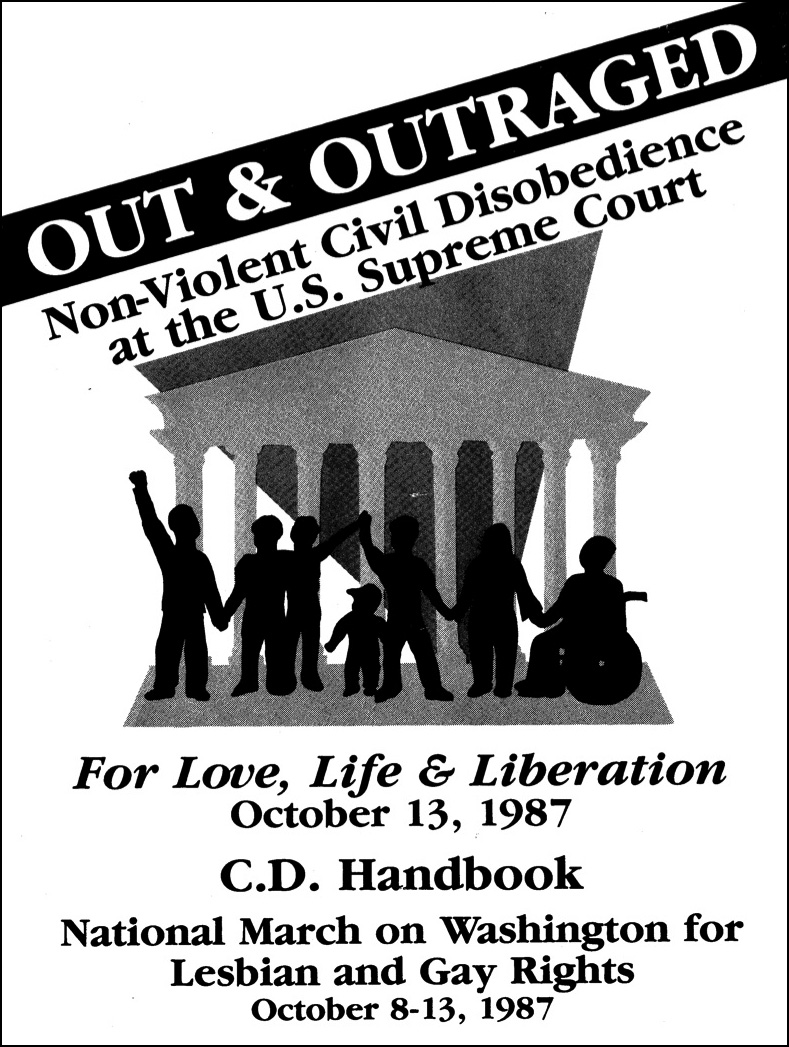
In the late 1980s it seemed there was no end to the AIDS crisis and increasing homophobia across Reagan-era America. The Supreme Court’s 1986 decision in Bowers v. Harwick upholding Georgia’s sodomy law led more than half a million LGBTQIA+ folks and allies to converge on Washington, DC from October 8-13, 1987 for what would become a series of historic events: The Lesbian and Gay March on Washington, the NAMES Project (aka the AIDS Quilt) and a mass civil disobedience action at the Supreme Court.
“This 1986 decision, upholding criminalization of our sexuality, marks a legal political trend that enables unprotected groups to become targets of scapegoating and discrimination… For Love, Life and Liberation – We Are Not Going Back” – National March on Washington for Lesbian and Gay Rights (from CD Handbook)
WRL sponsored a staff person at the march, and WRL National Committee members active with WRL New England, Nancy Alach and Laura Booth, were both involved nationally and locally in organizing for the civil disobedience action at the U.S. Supreme Court. They later wrote an article for The Nonviolent Activist reflecting on the significance of all that had taken place.
 Nancy and Laura were on the committee that prepared a handbook for the “For Love, Life & Liberation” direct action. Part of a long tradition of direct action handbooks, it drew from the Seneca Peace Camp and Blockade the Bombmakers Handbooks, and included contributions from Barbara Deming, Kate Donnelly, Clay Colt and others connected with the WRL.
Nancy and Laura were on the committee that prepared a handbook for the “For Love, Life & Liberation” direct action. Part of a long tradition of direct action handbooks, it drew from the Seneca Peace Camp and Blockade the Bombmakers Handbooks, and included contributions from Barbara Deming, Kate Donnelly, Clay Colt and others connected with the WRL.
-from Rutgers Digital Library of Nonviolent Resistance's summary of CD Handbook
Connecting Movements
Jamie Bauer was a WRL activist who had been part of the Women’s Pentagon Action and the Seneca Peace Camp. With toes both in the women’s movement and the peace movement, they had also gone to the War Resisters League for Training for Trainers of Civil Disobedience training. Around the time of mobilizing for the actions in DC, Jamie attended an early ACT UP meeting in NYC to make an announcement about the action planned at the Supreme Court, and ended up joining more meetings and to be an integral part of ACT UP. Jamie went on to become part of a group of one or two dozen people who trained over a thousand ACT UP folks in nonviolent civil disobedience over the years that ACT UP was most active. Read more about Jamie's activism in Sarah Schulman's “How ACT UP Defined Modern Protest: Organizers who fought the AIDS crisis explain how the tactics of civil disobedience can change minds that don’t want to be changed” and the amazing history of ACT UP in Schulman’s book, Let the Record Show: A Political History of ACT UP New York, 1987-1993.
Pictured: (Above) Two marchers push a third in a wheelchair; the person sitting in the chair is holding a sign that says "Marching for Life!". This picture appeared in the Jan/Feb 1988 issue of The Nonviolent Activist. Photo by Martha Tabor; (Middle) Cover of the CD Handbook; (Below) A page from WRL's Perpetual Calendar
- blog post by Sky Hall







